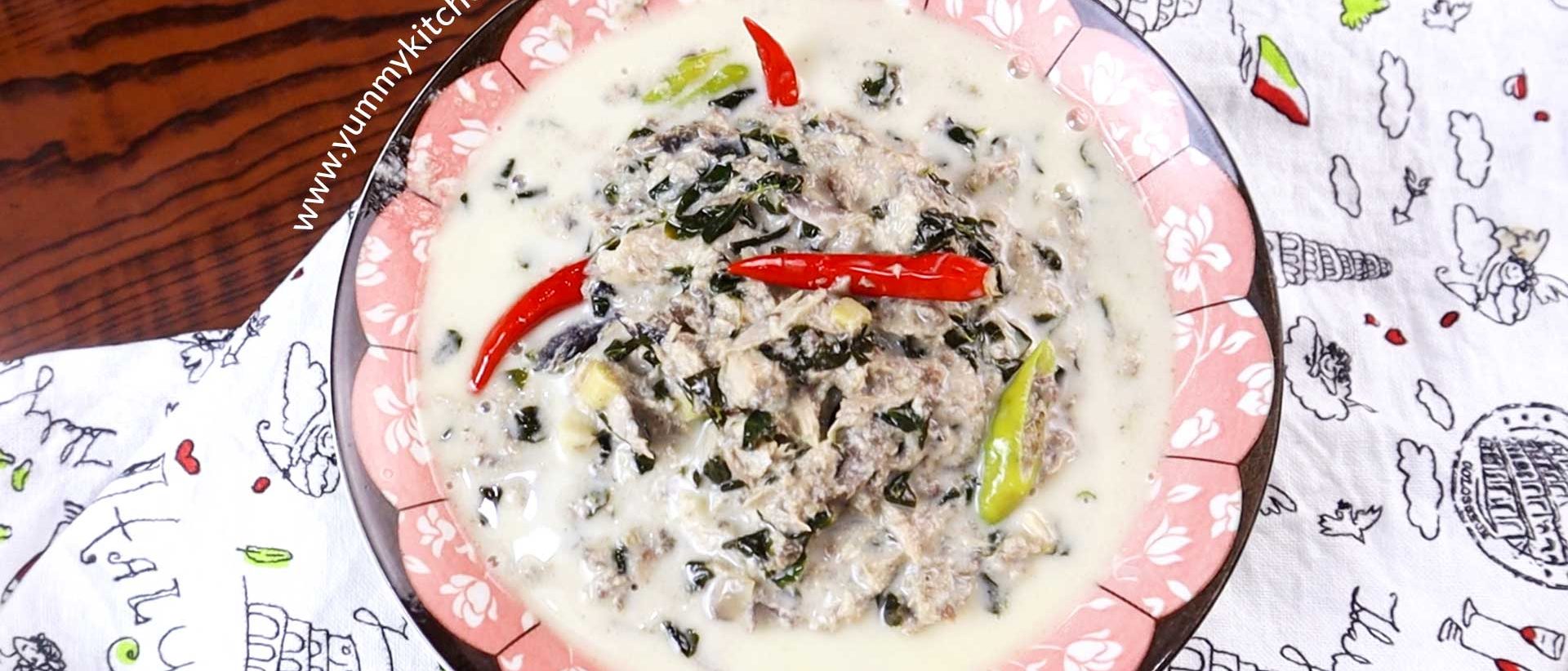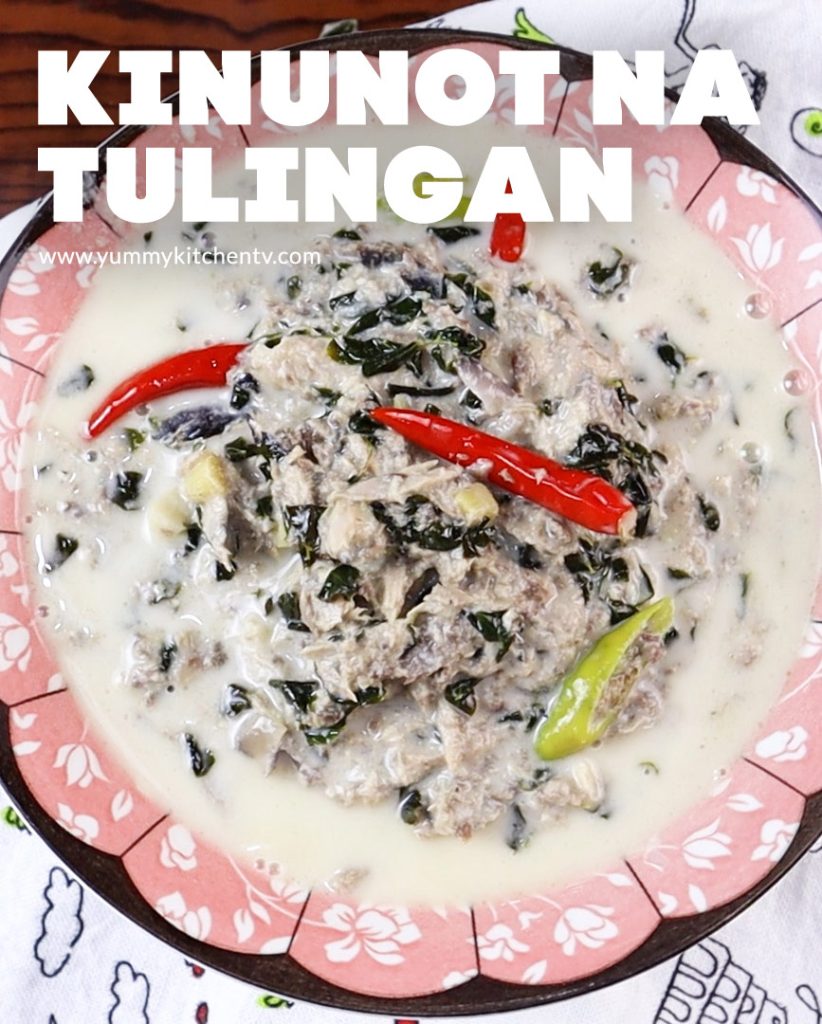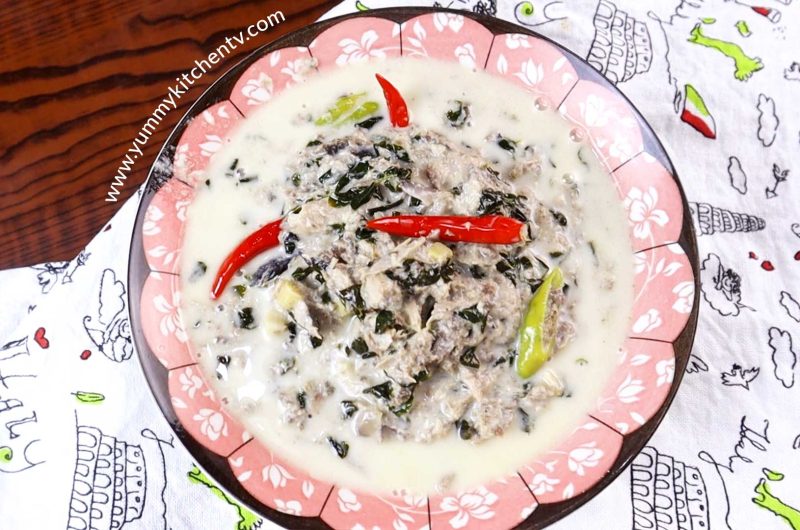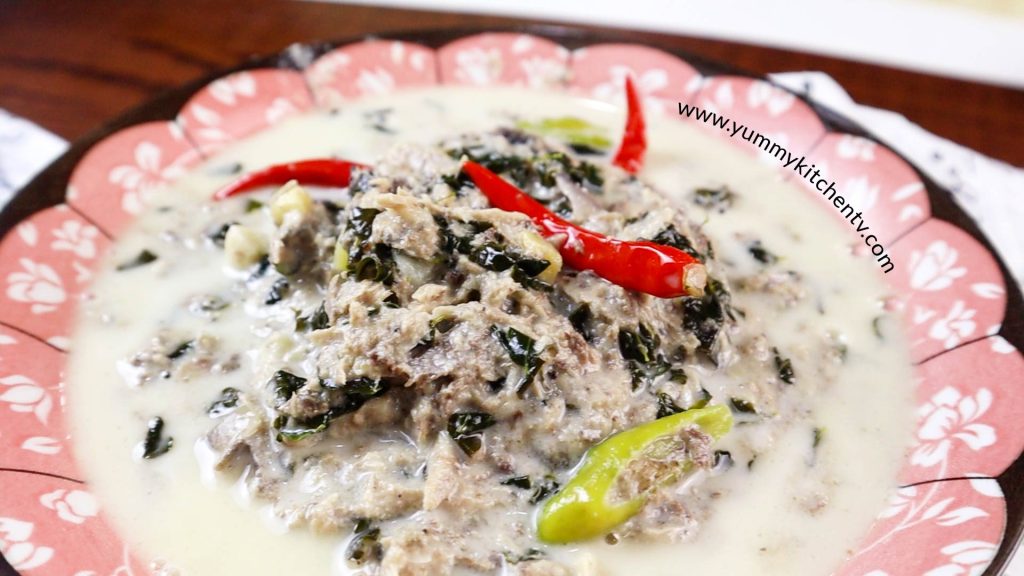Kinunot na Tulingan is Filipino delicacy originated from from the Bicol region where Tulingan, or Mackerel Tuna is simmered in a coconut cream concoction seasoned with ginger, garlic, onion, salt and pepper, with some malunggay and chilies. A yummy scrumptious and simple dish, the Kinunot na Tulingan is a dish that you can do anytime, a comfort food to some and a meal that you’d love to have a bite of when your looking for something sweet, east and spicy.
What is Kinunot na Tulingan?
Kinunot na Tulingan or ‘Kinunot’ is a Filipino dish with Bicolano origins. A dish made of flaked stingray, chilies and malunggay or moringa leaves simmered and stewed in coconut cream. A simple dish commonly eaten in the Bicol province ‘Kinunot’ the Bicolano term comes from the word ‘hinimay’ which means ‘flaked’ because you’re supposed to flake the fish, removing the bones, head, and sometimes tail before you add the fish meat back to the spiced stew. A famouse kinunot is called ‘kinunot na padi’ which is composed of malunggay, coconut milk, ‘padi’ or stingray. Other style of kinunot also uses shark meat, with other ingredients like fish sauce, ginger, garlic, onions, coconut milk instead of cream, and baby spinach. Kinunot na Tulingan is expecially popular in Bicol because chili peppers, seafood and coconut are abundant there. This is best paired with freshly cooked, steaming white rice on the side.
What is malunggay?
Malunggay or Moringa is a popular plant used as an herbal medicine. This plant grows in tropical climates and is used as an ingredient for cooking aside as medicine especially in countries like Africa, Philippines, and Indonesia. A nutritious plant with a long medical history and folklore added, and is also used to combat malnutrition in third world countries and are used by nursing mothers and infants. The parts of the malunggay has different uses, for example the malunggay pods are eaten raw or cooked, mostly fried to produce a colorless and scentless oil called ‘ben oil’. While the leaves are eaten or rather cooked in salads, soups, greens, and other tropical viands. These can also be mixed with other dishes like one would a leafy vegetable or fried in batter. Malunggay is also called the ‘miracle tree’ primarily because of the health benefits if provides, using not only the leaves and pods, but also the barks, roots, and flowers. Some uses of the malunggay leaves are the combination of the leaves pounded in coconut oil to help promote scalp growth. The malunggay leaves stewed in a dish or boiled alone can also boot nutrients needed to recover from sickness. It helps boost the immune system and help with the milk production for nursing mothers. Some uses with the malunggay leaves also include combining the heaves with calamansi and honey to make a drink to treat asthma and cough, skin rejuvenation, diabetes, relaxant, hypertension to lower your blood pressure, anthelmintic where the malunggay pod is chewed to prevent children from internal parasites. These are also a good way to get nutrients and minerals like calcium for bone strength, anti-inflamatory to treat inflammations like back pain, gout, sprain, rheumatism, and almost any sort of swelling in the body, this can also help to treat bones and ligaments relating to swelling as the above. Its anti-cancer and is used for constipation as a diuretic, helps improve eye problems as this contains a lot of vitamin a, actually having more than that of a carrot. This can help with treating skin problems such as, sores, skin ulcers, and cuts by washing the problem area with the water from boiled roots. There are a lot of positive benefits from eating malunggay so have a go and try it out yourself.
Fish is a healthy way of providing the nutrients needed for the body, but fish, packed with coconut milk and malunggay leaves? Well your body is in for a nice health conscious surprise!
Kinunot na Tulingan
Course: MainCuisine: Filipino4
servingsAn easy delectably creamy way to enjoy fish
Ingredients
3 pieces tulingan (cleaned with the guts removed)
5 cloves garlic; minced
1 medium sized onion (sliced)
2 thumb sized ginger (minced)
1 cups coconut milk
2 cups kakang gata
moringga leaves
1 tablespoon salt
1 teaspoon black pepper
1 green chili pepper
3 red chili pepper
cooking oil
Directions
- Prepare the tulingans, and season them with salt. Set aside.
- In a pan at medium heat, add oil and fry the fishes till each side turns light brown. Take it off the heat after. Set aside to cool.
- Shred the fishes with forks or your hands. Taking off the bones, tail, and head, leaving only the meat.
- In another pan, add oil and sauté the garlic, add in the sliced onions and cook till translucent, add ginger and the shredded tulingan. Mix well.
- Pour in coconut milk, season with salt and black pepper. Mix well and let this simmer. Cover and cook till the liquids have reduced.
- Mix in the kakang gata and malunggay leaves. Add the red and green chili peppers, stirring continuously till the liquid has reduced. Take it off the heat and serve.
Kinunot na Tunngan is a great way to enjoy coconut milk or coconut cream. With just a few indigents you can easily find at home or readily available in the supermarkets. There’s really no reason to not have this recipe a go. The meatiness of the tunngan fish, flakes to make it easier to consume once its added into the spiced coconut stew made of garlic, onions, ginger, kakang gata, salt and pepper, moringa or malunggay leaves all boiled down with the coconut milk and fish till it’s reduced. Added with red and green chilies to really give it a nice kick. this yummy dish is absolutely worth a try.
Kininot na Tunngan recipe (tagalog)
Sahog
- 3 piraso tulingan (nilinis at tinangalan ng laman loob)
- 5 butil ng bawang (tinadtad)
- 1 katamtamang laking sibuyas (hiwahiwa)
- 2 hinlalaking luya (tinadtad)
- 1 tasa coconut milk
- 2 tasa kakang gata
- malunggay
- 1 kutsarang asin
- 1 kutsaritang paminta
- 1 berdeng sili
- 3 pulang sili
- mantikilya
Paano lutuin
- Para ihanda ang tulingan, asinan ang mga ito at itabi.
- Sa kawali na may katamtamang init, lagyan ng mantika at iprito ang mga isda hanggang mag kayumanggi ang bawat gilid nito. Tanggalin sa init at palamigin.
- Himay-himayin ang mga isda gamit ang tunidor o mga kamay. Tanggalin ang mga buto, buntot, at ulo.
- Sa ibang kawali, lagyan ng mantika at lutuin ang bawang, isama ang mga sibuyas at lutuin hanggang maganino ang kulay, lagyan ng luya at hinimay na tulinagn. Haluin ng mabuti.
- Ibuhos ang coconut milk, lagyan ng asin at paminta. Haluin at ipakulo. Takpan ang lutuin hanggang kumonti ang sabaw.
- Haluin ang kakang gata at malunggay. Ihalo ang pula at berdeng sili, ituloy tuloy ang paghalo hanggang kumonti ang sabaw. Tanggalin sa init at ihanda.






